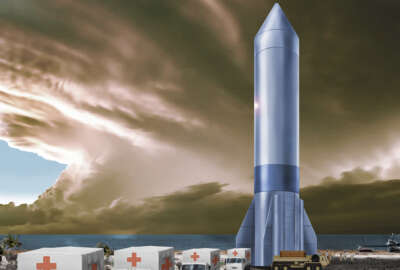
What’s taking so long for the Army to update its on-base lodging?
The Army has expanded its temporary lodging improvement plans out to 2029.
The DoD Reporter’s Notebook is a weekly summary of personnel, acquisition, technology and management stories that may have fallen below your radar during the past week, but are nonetheless important. It’s compiled and published each Monday by Federal News Network DoD reporters Jared Serbu and Scott Maucione.
The Defense Department has been dealing with the aftermath of privatizing its military housing, now a government watchdog thinks the Army should step up its oversight of temporary lodging as well.
The Army began privatizing its lodging in 2009 to save money, but a Government Accountability Office report found improvements are taking longer than anticipated, development plans have changed and there is a lack of data to actually determine if the program is achieving its intended objectives.
“The Army determined in 2003 that over 80% of its lodging facilities were in need of either replacement or renovation at a cost estimate of over one billion dollars,” the authors wrote. “In addition, the vast majority of the facilities did not meet Army adequacy standards. Many of the lodging facilities had cinder-block walls, exterior corridors, linoleum floors, and lacked standardized in-room temperature control units, while others had deficiencies in the life-safety systems, such as fire alarms and sprinkler systems.”
The Army said it has seen increases in guest satisfaction rates. It also extended its renovation plans out to 2029 — years longer than originally intended — and changed development plans to be more renovation-centric, as opposed to building new lodging.
“The Pentagon has not included information on the Army’s revised timeframe or development plans in its reports to Congress,” the authors wrote. “If DoD were to provide this additional information, Congress and other decision makers would be better able to determine whether the lodging program is achieving its intended objectives.”
GAO also suspected that the Army’s reported cost savings from the program are overblown.
“The Army estimated a cost avoidance of approximately $606 million for official travel lodging costs from fiscal years 2009 through 2019, using a baseline that is higher than what the Defense Travel Management Office uses and what off-base commercial preferred hotels may charge,” the GAO analysts wrote. “However, the Army has not evaluated whether the calculation it uses or an alternative is the most accurate representation of the cost avoidance achieved.”
GAO said DoD is being negligent in the way it collects data on the lodging as well. There are issues with how standardized the data is, leading to compliance reports that are not easily comparable year by year or installation to installation.
The watchdog is making four recommendations. One is that the Army provide key information about the lodging privatization program so that Congress can get a handle on the status of facilities and the timeframe for completing improvements.
GAO also wants DoD to look at how the Army is coming up with its cost avoidance numbers and calculate them against other scenarios.
DoD should create standardized methodologies for the data it collects on lodging and finally it should look into why some service members and civilians are inappropriately using off-base lodging for official travel.
DoD saw that issues with data collection and deferments on improvements ended up being huge issues for military families living in privatized housing.
The Pentagon and the military services repeatedly said they took their “eye off the ball” when it came to improving old houses with lead paint and to getting maintenance issues fixed for families.
The GAO report has some similarities, particularly in terms of oversight issues, to the 2006 report that warned about future problems with military housing — those issues came to a head starting in 2019.
TRANSCOM will work with Air Force on Rocket Cargo project
U.S. Transportation Command said it will partner with the Air Force in the service’s journey to use terrestrial rockets to deliver cargo and possibly humans anywhere in the world in short timeframes.
The combatant command announced last week that it will work with the Air Force Research Laboratory (AFRL), the Air Force and the Space Force to explore commercial capabilities in the field of space travel for global logistics.
AFRL will be leading the effort and TRANSCOM will provide a supporting role.
“DoD has explored space transportation in the past,” Navy Lt. Cmdr. Andrew Moore, who is managing the partnerships, said. “Today, multiple factors are at play and it is the convergence of favorable costs, capacity, speed and access that makes commercial space mobility and logistics increasingly attractive.”
The Air Force is relying heavily on private industry to build the capability.
“Since industry bears the bulk of development costs, the government is in an opportune position to influence designs and be postured to utilize future capabilities,” said Moore. The strategy aligns with the 2020 National Space Policy to develop government systems only when no suitable or cost-effective service is available.
According to Moore, it is similar to how the DoD works with commercial aircraft engineers to ensure compatible defense features such as the 463L pallet system, which is a common size platform for bundling and moving air cargo, and serves as the primary air cargo pallet for the U.S. Air Force, other air forces, and many civilian cargo transport aircraft.
The Air Force announced the vanguard program on June 4.
“Rocket cargo is envisioned as a Defense Department interface with commercial capabilities, where we deliver up to 100 tons of cargo anywhere on the planet on tactical timelines,” Maj. Gen. Heather Pringle, AFRL commander, said. “This newest vanguard has the support of the entire Department of the Air Force, and if successful, will be partnered with the right team to transition this to warfighters.”
As the private sector works, AFRL and the Space and Missile Center are planning prototypes and experiments to ensure cargo will be ready for terrestrial rocket travel.
That includes looking at ways to pre-certify cargo and containers to quicken the packing process, finding ways to quicken the logistics of packing and unpacking cargo and even entertaining the possibility of using the rockets to rapidly deploy troops.
The Air Force is working under the assumption that companies will develop landing pads around the world, but the service would also like to look into landing the rockets in austere environments that could deliver capabilities to nearly anywhere on the planet.
“People always wonder why are we looking at this idea again. This idea [has] been around since the dawn of spaceflight, it’s always been an intriguing idea. We look at it about every 10 years and it’s never really made sense in the past,” Greg Spanjers, Rocket Cargo program manager said. “What has changed is a major emergence on the commercial side with much higher capability rockets at a much lower cost point than we’re used to seeing.”
At this point, companies are using their own money for reentry systems and DoD does not have to do the initial investment.
Copyright © 2025 Federal News Network. All rights reserved. This website is not intended for users located within the European Economic Area.
Scott Maucione is a defense reporter for Federal News Network and reports on human capital, workforce and the Defense Department at-large.
Follow @smaucioneWFED
Related Stories





